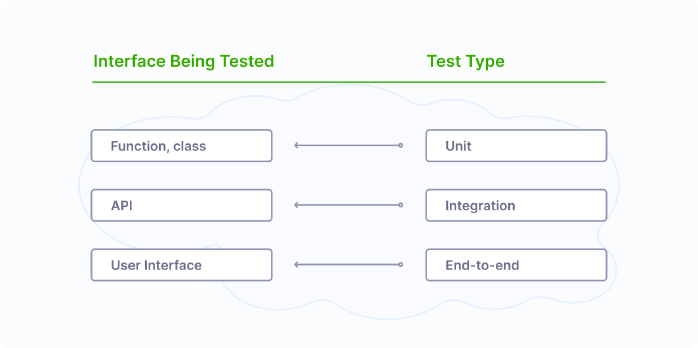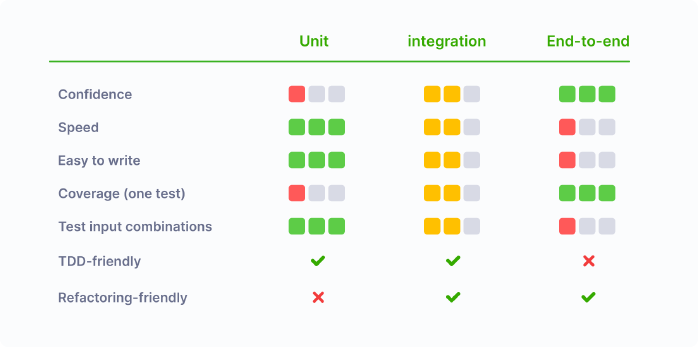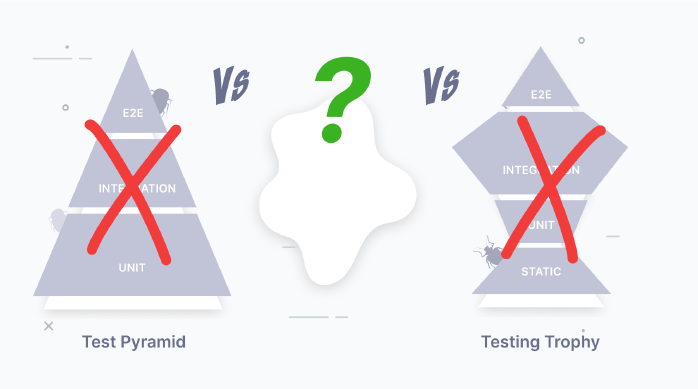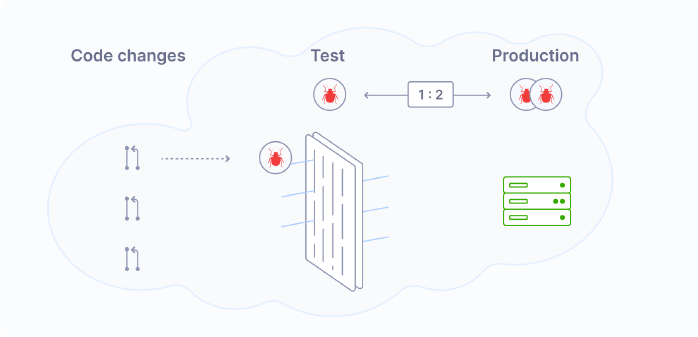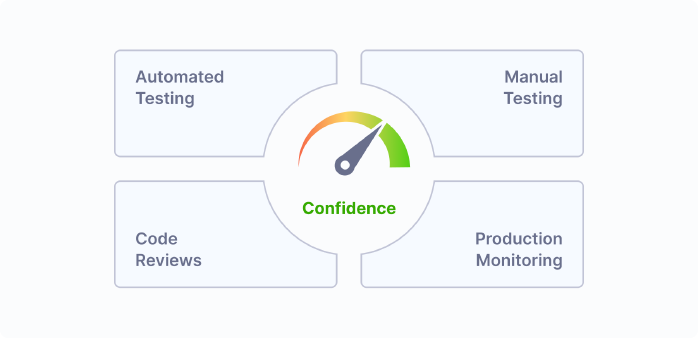If you're interested in automated testing, you might have seen some contradictory advice. For example, there's a well-known Test Pyramid, suggesting that we should focus mostly on unit tests. And there's another approach called Testing Trophy, which suggests that we should mostly write integration tests.
Some posts argue that unit tests are overrated, and others - that they're fine. Which advice should we follow? Choosing the right testing strategy isn't that simple, and the choice will have long-lasting consequences. At Ivelum, we've built and maintained dozens of complex systems, and this post summarizes what we think about this balance today. Let's dive in.
Terminology
People most commonly refer to unit, integration, and end-to-end tests—and those will be the focus of this post. Of course, this isn't the only way to categorize tests. You might also have come across terms like smoke, functional, system, or contract tests, each of which serves its own purpose. To keep things simple, I won't cover every type of test here, but the core ideas discussed below apply to them as well.
What is being tested?
Each test interacts with some interface, and the interface being tested defines the test type:
- Unit tests verify the behavior of a small piece of code, such as a function or a class;
- Integration tests work with larger pieces of code. Often, this is a code behind an API;
- End-to-end tests work with the program from the end user's perspective by interacting with the UI.
Comparison: Unit - Integration - E2E
Now, let's see how these types of tests compare to each other. Let's start with the most important which is...
✅ Confidence
High-level tests, like integration or end-to-end, provide the best confidence. Maybe you've seen memes on the internet like this. If all the low-level tests pass, it doesn't guarantee that our app works as a whole.
Confidence is the most important reason why we even bother with testing. If we spend time and effort on testing, but the confidence level remains low - it doesn't seem like a good investment. This is why we list "Confidence" first. However, it's not the only criterion.
🏎️ Speed
The more code under the test, the slower the test is—no surprises here. This is especially noticeable with end-to-end tests because we run not just one program but two—our app and another program through which we test. In the case of web apps, it's a browser managed by a framework like Selenium or Playwright. As a result, end-to-end tests are the slowest and require more resources like CPU and memory, and their setup is more complicated.
✨Ease of use
Writing and debugging end-to-end tests could be more challenging. The biggest complaint you may hear is that they're flaky. You run the test once, and it works. You run it once again, and it fails! Run it one more time, and now it works again! This problem is so widespread that some people resort to retrying failing tests automatically, hoping they'll eventually pass.
Why are end-to-end tests flaky? It comes down to how browsers work—handling network requests, user input, JavaScript, and rendering all at once. If any of these take a bit longer, it can cause unexpected timing issues or transient states that throw off the test. A well-written test accounts for this by checking intermediate states and waiting for elements to load, making it stable and reliable. But simpler tests often skip these steps. They usually work—but sometimes fail without clear reasons. That's why flaky tests are common: writing them properly is just more complex.
📊 Coverage (one test)
Unit tests operate on small pieces of code, such as one function or a class, so one test can cover only so much. Higher-level tests cover larger pieces of code at a time, which may be helpful when starting with automated testing. If the codebase has no tests yet, just a few end-to-end or integration tests may quickly provide decent coverage.
I don't think chasing a very high percentage of coverage makes sense, though. As coverage grows, it becomes less and less useful as a metric, and 100% coverage won't guarantee the absence of bugs. However, going from 0% to 50-70% would certainly make a difference.
🔀 Testing input combinations
In theory, we could use any test type to validate all desired input combinations. In practice though, it could be painful to do with slow running tests.
Let's say we have a sign-up form that accepts a user's name, email, and password, and we would like to test five input combinations for each field. It may include a very long name, names in different languages, an already existing email, a password that is too short or appears in a leaked password database, etc. Testing all 5 x 3 = 15 combinations with end-to-end tests will take significant time. And this time quickly adds up! If we test all input combinations in the app this way, end-to-end tests will run forever.
Instead, we could use a hybrid approach. It would be enough to test just two combinations with an end-to-end test: a happy path and when an error occurs. Then, we could cover the rest of the combinations with unit or integration tests, which would work much faster, and with a couple of E2E tests covering our back, there will be no degradation in confidence.
🤝 TDD-friendly
While it is technically possible to use TDD with any test type, I'd argue that it doesn't play well with end-to-end tests due to their slowness. When using TDD, people tend to run tests often, and if they are slow, it would be too painful to build the program this way.
I'm not saying that we should always use test-driven development, though. As with any technique, it has limitations and works great in some situations and not so great in others. I'm just saying that it's much easier and more enjoyable to use TDD with fast tests.
♻️ Refactoring-friendly
By definition, refactoring means restructuring the code without adding new features. Restructuring the code, in turn, means that the internal interfaces in the code might change—we might add or remove functions or classes or change their call signatures.
This process slows down significantly if these functions or classes are heavily covered with unit tests, which is often the case in projects that meticulously follow the Test Pyramid.
Conversely, high-level tests can significantly boost refactoring speed since they provide a quick way to verify that the program works as before from the end user's perspective.
Side-by-side
So what should we use?
Looking at the table above, we see no clear winner. Integration tests may look more balanced (and I like them), but they're not a silver bullet and aren't the best for every situation. So the answer is good old "It depends." Yes, boring, but true.
I think methodologies like Test Pyramid or Testing Trophy do more harm than good. Their original explanations are rational and nuanced, but their most memorable artifact is the simple picture that clearly shows the "default" test type—unit, in the case of Test Pyramid, or integration, in the case of Testing Trophy. Most people remember only this.
When developers adopt one of these methodologies, they often just go with the "default" test type if they don't immediately see reasons not to use it. This is a mental shortcut. It requires less thinking but results in suboptimal testing suites - less robust, more complex, or slower than they could be.
A better target
Instead of focusing on specific test types, we'd better focus on values: What do we like to achieve with testing?
We certainly want Confidence—it's the primary reason why we even bother with testing. We also want Speed; the faster our tests are, the better. And it all comes with a price, and the price is Effort. Our users don't care about our test suite; they care about features. Kent Beck, the author of TDD, summarized it perfectly:
My philosophy is to test as little as possible to reach a given level of confidence.
I think this diagram of balancing confidence, speed, and effort is a much more useful concept to remember than any methodology based on balancing different test types.
How to find the right balance?
We probably can't measure this balance precisely, but we can develop some intuition about good and bad for each axis.
✅ Confidence as a measure of bugs filtering efficiency
Our test suite works like a filter between our code and production, catching bugs. The efficiency of this filter is a measure of confidence. If our tests never fail, the filter is useless—it doesn't catch anything. By looking at bugs caught by tests and bugs sneaking into production, we can get an idea of how efficient the filter is and what level of confidence we get from tests.
🏎️ Speed: What is fast and slow?
How long does it take to run the full test suite when pushing a change to production? If it's measured in minutes, excellent! If it takes hours, that's too bad, and there's a grayscale in between.
A common trick to speed it up is to run tests in parallel. A multi-threaded test runner and a powerful server might be enough for a small project. For large projects, it may require a significant investment. For example, Stripe, in its annual letter, mentions its test infrastructure as its largest distributed system:
The biggest distributed system at Stripe is our testing system. Stripe now comprises more than 50 million lines of code. Each change is verified within 15 minutes by running a battery of tests that would take 50 days to run on a single CPU.
🧭 Guiding our effort
No matter how good our test suite is, it must never be the only way of achieving production stability. If we do automated testing, that's great, but it doesn't mean we can abandon manual exploratory testing. It doesn't mean we can get rid of code reviews or that there's no need for production monitoring. All these measures are essential and complement each other to give us the level of confidence we need.
When a production incident occurs, we should track its root cause and ask ourselves: How could it be prevented? Sometimes, the answer is "write a test," but not always. It could also be improving processes, monitoring, or something else. This will guide our efforts.
Bottom line
Don't chase that magical test proportion - it doesn't make sense. Better look at how you could test this particular feature with good confidence, minimal effort, and reasonable speed, and don't hesitate to use whatever kinds of tests if they fit the job.
And if you're looking for a development partner that combines confidence, speed, and pragmatism—Let's talk!
.png)


